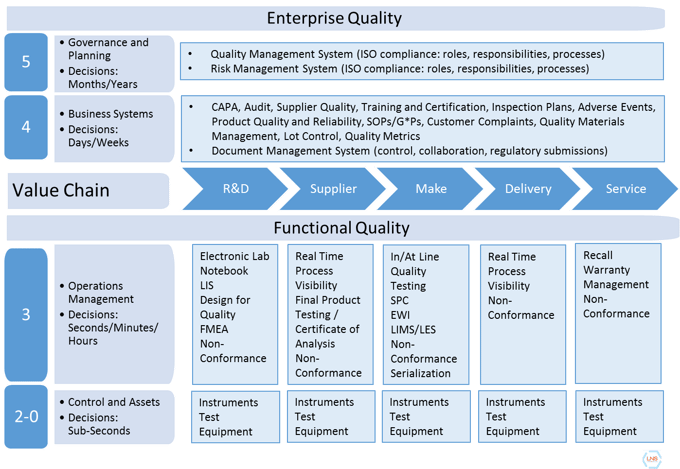 Quality has many different definitions depending on who you ask. Executives often refer to quality as a core value. Customers experience quality in reference to the utility derived from the product or service purchased. Quality leaders believe in a framework for quality that ties together people, processes, and technologies that spans the value chain, while value chain leaders think about quality in how it relates to the specific functional goals they may have.Due to all of these differing definitions, it is no wonder that so many organizations are challenged to include quality applications into the enterprise architecture that integrates quality into end-to-end business processes. Just because it is challenging doesn’t mean companies shouldn’t pursue a total quality definition.
Quality has many different definitions depending on who you ask. Executives often refer to quality as a core value. Customers experience quality in reference to the utility derived from the product or service purchased. Quality leaders believe in a framework for quality that ties together people, processes, and technologies that spans the value chain, while value chain leaders think about quality in how it relates to the specific functional goals they may have.Due to all of these differing definitions, it is no wonder that so many organizations are challenged to include quality applications into the enterprise architecture that integrates quality into end-to-end business processes. Just because it is challenging doesn’t mean companies shouldn’t pursue a total quality definition.
Companies that haven’t included quality as a key aspect of enterprise architecture (EA) end up with many disparate quality software systems, often with overlapping capabilities in some areas and gaps in others. These companies also struggle to make timely and effective decisions when purchasing software, often comparing apples to oranges. And perhaps most importantly, companies without a common enterprise architecture that includes quality software systems struggle to support and enable best practices for business process and leadership capabilities.
To help companies develop an enterprise architecture that is inclusive of quality systems and that all of these different leaders can agree upon, LNS Research has developed an infographic that builds upon and extends the ISA-95 activity model for manufacturing systems. The ISA-95 framework is a great starting point because it has a broad and common understanding across different industries, and simply defines activities managed by software in reference to the decision timeframe these activities operate under. As examples: a Sales and Operations Planning (S&OP) process that makes product or production decisions that could be months or years out would operate at Level 5, while real-time monitoring of in-process quality parameters may be at Level 1 or 2.
However, there are many gaps within the framework that had to be considered while extending it for end-to-end quality. First and foremost, the ISA-95 model was primarily developed by Manufacturing Operations Management (MOM) professionals for MOM professionals, so there is an incredible amount of detail in Level 3 but much less detail in the other levels. Additionally, because it is so focused on manufacturing operations, the other aspects of the value chain are significantly under-represented or non-existent. Only by looking at quality across all these dimensions are we able to address these gaps without overwhelming the users with detail or scope.
Enterprise Architecture for End-to-End Quality
 It is our belief that this new infographic can help your organization:
It is our belief that this new infographic can help your organization:
- Develop an enterprise architecture inclusive of quality
- Better understand how the quality capabilities of applications like PLM, ERP, CRM, EQMS, MOM, and LIMS fit together across all aspects of the enterprise,
- Provide a common language for leaders across the value chain to discuss quality software, and once and for all
- Answer the often posited question of why MES may not be the best option for an enterprise CAPA system, once and for all.
Gain a year of free access to new research in our IoT Research Library by completing a survey.